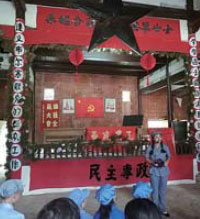City perfectly placed to welcome tourists
Known as the "Red Capital of China", the city of Ruijin in Jiangxi province is perfectly suited to welcoming the influx of visitors that have embraced the "Red" tourism craze.
Both the streets and the air are clean, and the subtropical weather results in abundant trees and greenery.
The city is renowned in Chinese folklore as the cradle of the Chinese revolution that was led by the Communist Party of China and eventually resulted in the establishment of the People's Republic of China on Oct 1, 1949.
Mao Zedong and Zhu De established the central revolutionary base in Yeping village in late September 1931 after defeating the first three Kuomintang offensives.
In 1931, the First National Congress of Workers' and Peasants' Representatives was held in Yeping village.
Around 610 representatives from all over the country gathered in the hall that still stands today. At the congress, which marked the founding of the Chinese Soviet Republic, laws on labor, land and marriage were passed, and the first outline of the constitution was agreed. Sixty-three representatives formed the Central Executive Committee, the organ of supreme power, and Mao, then 38 years old, was elected chairman.
Visitors to the hall can see 15 small rooms that are boarded up. The rooms served as the offices for the nine ministries of the Chinese Soviet government, including the ministries of finance, education, land and foreign affairs.
On the same site, there is another building that was constructed in 1924, where five major leaders of the central government lived and worked, including Mao and Zhu.
At the rear of the building stands a camphor tree that is more than 1,000 years old. The ancient tree has survived a lightening strike, as well as the passage of time.
When the Red Army arrived, they found that many elderly people had been left alone and destitute, as their grownup children had joined the army.
As a result, they were housed in the building and looked after by the Red Army. Among other acts of benevolence, senior officers donated their rations to the elderly residents.
In April 1933, the central government in Yeping village was betrayed to the Kuomintang, who sent aircraft to bomb the village. One day in 1933, while Mao Zedong was reading in the building, a bomb landed in the camphor tree but failed to explode.
Following the incident, the central government was relocated to Shazhouba in Ruijin.
|
A tour guide introduces the Party's history to visitors in Ruijin, Jiangxi province. Lu Zhongqiu / For China Daily |
The buildings in Shazhouba are also well preserved and, like Yeping, the environment is also pleasant. Besides the former building of the central government, attractions include the great hall, which was built later for the Second National Congress of Workers' and Peasants' Representatives.
At this time, after discovering that the villagers lacked easy access to clean drinking water, Chairman Mao ordered his soldiers to build a well. Visitors can still drink water from the well today, while enjoying the sights of the rest of the scenic spot that covers an area of 400,000 square meters.
In October 1934, the Red Army failed in its attempt to stop the Kuomintang's fifth offensive, so the central government decided to leave Ruijin and subsequently started the Long March.
yangyang@chinadaily.com.cn
(China Daily 08/25/2016 page7)















